Thermaltake Mozart TX Case with 7in Display Review
Thermaltake Mozart TX Case with 7in Display
We like our coffee strong, our internet stable and our wombats furry. But we don't like big cases.
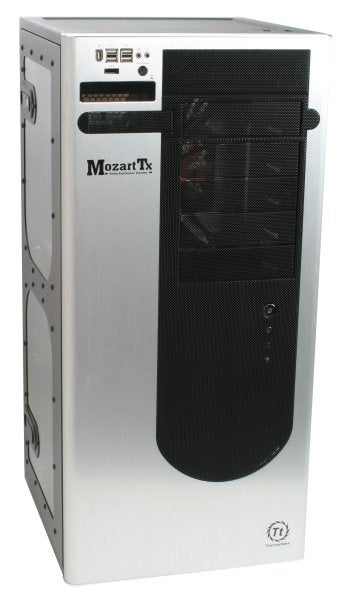
Verdict
When the Mozart TX arrived in the office, my first impression was that it was a similar size to a shuttle. No – not the popular SFF brand, but in fact a real shuttle. Benny’s first reaction was “is that a case, or a fridge?” and Riyad felt it looked more like a cabinet than a case. This thing is huge!
Ok, jokes aside – this thing is big. It’s just over 720mm tall, 330mm wide and 360mm deep. That’s bigger than two full sized ATX cases side by side (that’s the really tall ones, not the midi cases most of us have). The desks in our office are between 690-710mm high, while my home desk is 715mm. Neither of these are high enough to accommodate this behemoth of a case. However, by removing the cheap plastic feet from the bottom of the case, I could just about slide this under my main desk.

Not being able to fit it under your desk is not the end of the world though. It would fit quite nicely next to a desk, where it’s high enough to actually extend available surface area. It is even indented slightly, almost suggesting that a mouse mat could be placed on top.
Even before actually installing anything into the case, it’s incredibly heavy. I kept my osteopath in business just by lifting the box in an awkward position. The weight is primarily due to its steel construction. Making this out of aluminium would have rocketed the price sky high but kept the weight down. Once a full machine is in place, it’s a complete pain to move. You’d think then, that Thermaltake would have put carry handles on the case, or even wheels, but no. This is a slipped disc waiting to happen.
From the front, it’s not an unattractive design, with its aluminium fascia. It looks like someone has taken a standard case design and just upscaled it. You’ll see five 5.25in bays for optical drives, a single 3.25in drive bay, and a 7in bay (more on that later). 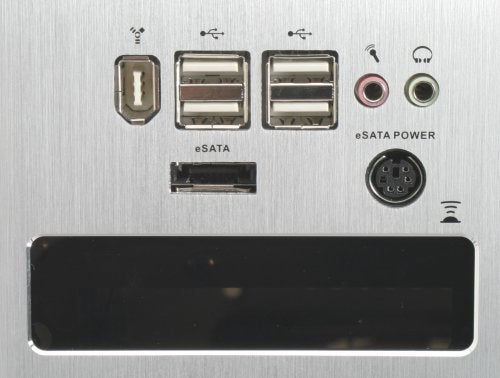
At the top of the case, for easy access (assuming you can fit this under your desk), is a six-pin FireWire connection, four USB 2.0 connectors, microphone input and headphone output. Interestingly ahead of the curve, we also find an eSATA connector and eSATA power connector. The power connector is an odd, S-Videoesque affair that I’ve not seen before. As far as I know, there isn’t a standard for eSATA power connectors yet and there was no cable included (although most eSata drives come with their own power supplies and data cables).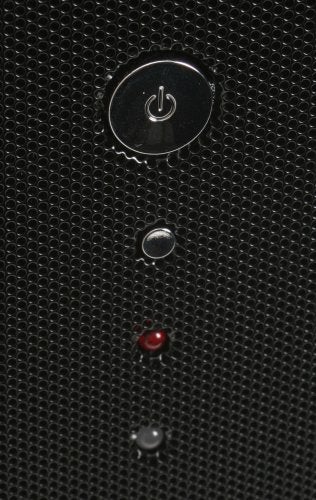
The power switch feels cheap, finished in chrome plastic to match the reset button.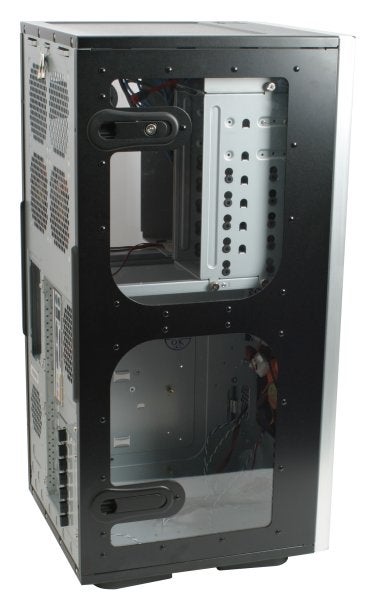
Both sides of the case have giant hinged doors with dual window design. There are thumbscrews holding them in place, but frankly these aren’t really needed. A quick pull of the handles at the top and bottom and the door swings open. 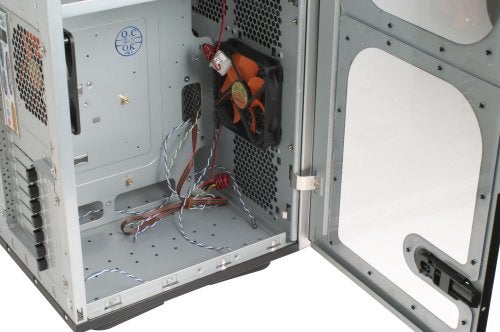
On this side, there is room to fit a full-sized motherboard. You can also see two of the five included 120mm case fans. Because of the size of the case, this is literally all this quadrant is designed for, so there is plenty of room for fiddling around and installing any watercooling equipment.
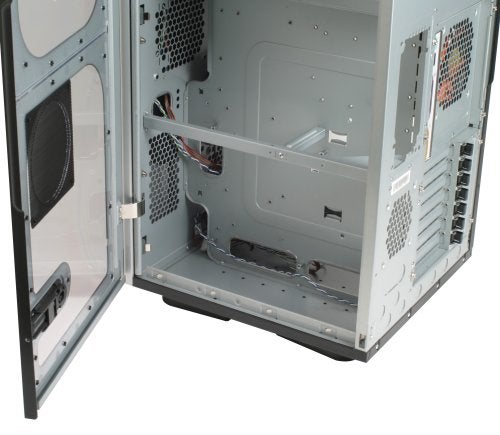
On this side, you can see where the PSU fits. There is also room to fit a secondary Mini-ITX motherboard. With a little re-jigging of the design, I feel this could have been suitable for the less expensive MicroATX motherboards. It’s also worth noting, that there is no room for a secondary PSU. Instead, Thermaltake expects you to either purchase its Mini-ITX expansion kit (which is just a PSU that fits in to a 5.25in bay), or use something like a PicoPSU.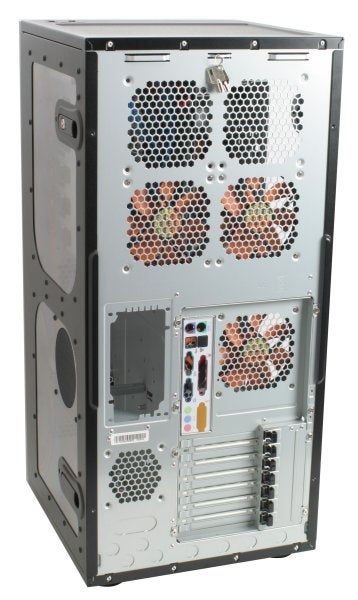
From the back, you get a much better idea of scale – seeing the 120mm fans all lined up. There are the three at the rear, and then another two at the front of the case. 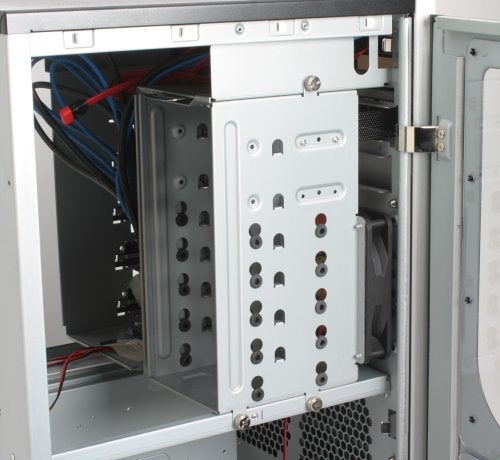
This is the top right portion of the case. This module is removable for installing hard drives. There are also rubber grommets included, to help reduce vibration. 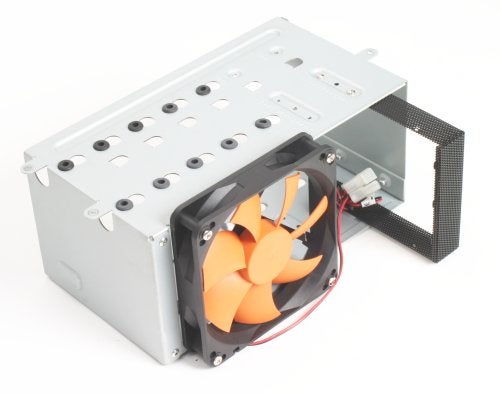
The module itself also includes a fan, to help keep the hard drives cooled. You’ll have to remove this in order to install any optical drives.
You’ll also be wondering what that 7in bay is for. This is actually for installing an optional extra – a 7in TFT screen.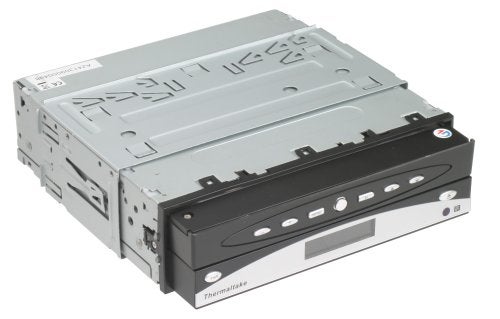
This is actually a rebadged Worcol display, that would usually be fitted in a car. Anyone who has fitted a car stereo before, will recognise the cage that holds it in place. Installing this had me baffled for a while, as I couldn’t affix the cage in the case. It turns out, that instead of the traditional screw system, you have to just bend through some pieces of metal to hold it in place (just like in a car Spode – ed.). However, once the unit is installed and the fascia is back on, it is held in place quite tightly. 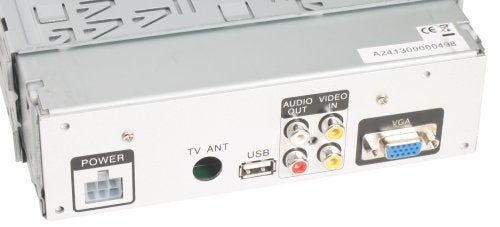
On the back, you’ll see the D-SUB output, audio output, USB connection and power. The power looks strangely familiar to a PCI Express connector, and the keying of the connector is very similar too. It wouldn’t take much effort to accidentally fit one. However, you’d probably end up killing the device as a couple of the 12V and ground wires are the wrong way around.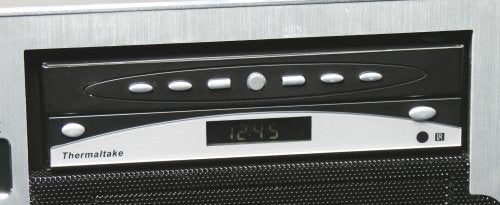
Here the display is fitted and looking like it’s meant to be there – rather than an obvious hack job to get a car unit in to a PC. You might be wondering what the USB connection is for – it’s there because the display is a touch screen. It even comes with drivers for Linux. 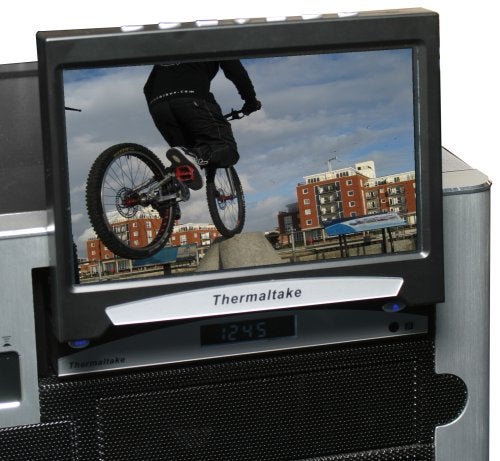
As this uses a D-SUB connection, quality was pretty awful. The contrast ratio is only 250:1 and there was a wave washing its way across the screen that was far too distracting. Getting a photo of it in action was difficult, so I’ve just GIMPed an image onto the screen instead to give you an idea of the device in action. One thing’s for sure, you’re going to want to try out the screen module before splashing the cash.
At £196.21, this 7in screen seems like an awful waste of money. In a car, you’re limited to this type of display, but £200 will buy you a fairly decent secondary monitor or TV to watch your films on at home. These of course would have a lot more functions too.
At this stage, you might still be wondering – why on earth is the case so big? I think Thermaltake is pitching for the dual PCs in one case idea. However, out of the box, this isn’t possible (as mentioned earlier with the PSU problem). So you spend a little bit more money and you have a Mini-ITX motherboard and a full sized ATX motherboard. This could be handy, as you could set up the Mini-ITX PC as a file server, and then have the main PC access this data across the network. The benefit of this is that you can keep the file server on 24/7 and chewing a lot less power than your SLI 3D Powerhouse next door.
Nice idea. But why keep the whole lot in one box? This seems needless and inflexible. The whole Mini-ITX idea feels like a botch job that has been poorly executed and not properly thought through. If you want a file server, build one, or buy a NAS box.
I’m sure that some people will love this case. Many people just want the biggest case they can get, for fitting watercooling kits, masses of hard drives, and enough case fans to cause a temporal rip in the space time continuum.
However, at £148.04, not only does the case seem cheaply constructed, but the 7in display seems like a waste of money and a poor idea – nothing more than a gimmick, especially for an extra £200.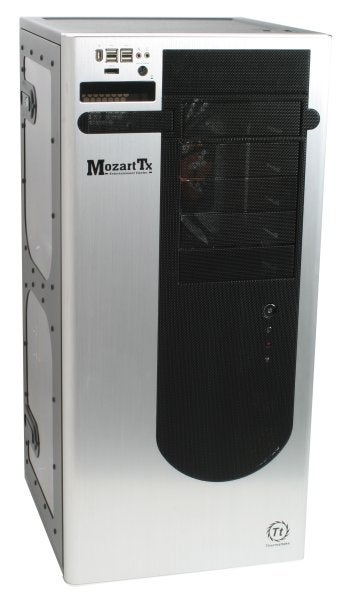
”’Verdict”’
If you like the look of this case, the chances are you don’t care what I have to say about it. And by all means go for it. However, I feel this is a case with no real target market, and has little benefit over a decent midi sized solution.

